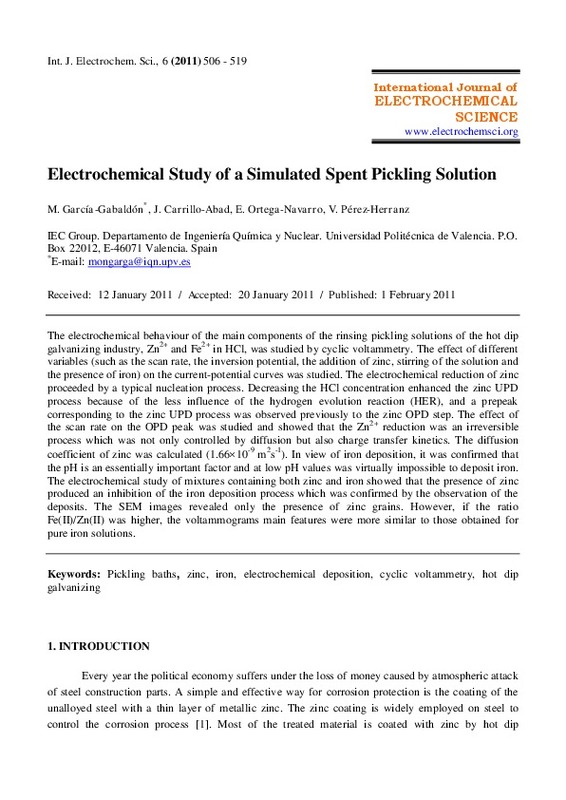JavaScript is disabled for your browser. Some features of this site may not work without it.
Buscar en RiuNet
Listar
Mi cuenta
Estadísticas
Ayuda RiuNet
Admin. UPV
Electrochemical Study of a Simulated Spent Pickling Solution
Mostrar el registro sencillo del ítem
Ficheros en el ítem
| dc.contributor.author | García Gabaldón, Montserrat
|
es_ES |
| dc.contributor.author | Carrillo Abad, Jordi
|
es_ES |
| dc.contributor.author | Ortega Navarro, Emma María
|
es_ES |
| dc.contributor.author | Pérez Herranz, Valentín
|
es_ES |
| dc.date.accessioned | 2016-05-04T12:18:46Z | |
| dc.date.available | 2016-05-04T12:18:46Z | |
| dc.date.issued | 2011-02 | |
| dc.identifier.issn | 1452-3981 | |
| dc.identifier.uri | http://hdl.handle.net/10251/63617 | |
| dc.description.abstract | [EN] The electrochemical behaviour of the main components of the rinsing pickling solutions of the hot dip galvanizing industry, Zn(2+) and Fe(2+) in HCl, was studied by cyclic voltammetry. The effect of different variables (such as the scan rate, the inversion potential, the addition of zinc, stirring of the solution and the presence of iron) on the current-potential curves was studied. The electrochemical reduction of zinc proceeded by a typical nucleation process. Decreasing the HCl concentration enhanced the zinc UPD process because of the less influence of the hydrogen evolution reaction (HER), and a prepeak corresponding to the zinc UPD process was observed previously to the zinc OPD step. The effect of the scan rate on the OPD peak was studied and showed that the Zn(2+) reduction was an irreversible process which was not only controlled by diffusion but also charge transfer kinetics. The diffusion coefficient of zinc was calculated (1.66. 10(-9) m(2) s(-1)). In view of iron deposition, it was confirmed that the pH is an essentially important factor and at low pH values was virtually impossible to deposit iron. The electrochemical study of mixtures containing both zinc and iron showed that the presence of zinc produced an inhibition of the iron deposition process which was confirmed by the observation of the deposits. The SEM images revealed only the presence of zinc grains. However, if the ratio Fe(II)/Zn(II) was higher, the voltammograms main features were more similar to those obtained for pure iron solutions. | es_ES |
| dc.description.sponsorship | Montserrat Garcia Gabaldón wants to express their gratitude to the Universidad Politecnica de Valencia for the economical support in the project reference: PAID-06-08, and to the Generalitat Valenciana for the financing of the project reference: GV/2010/029. | |
| dc.language | Inglés | es_ES |
| dc.relation.ispartof | International Journal of Electrochemical Science | es_ES |
| dc.rights | Reserva de todos los derechos | es_ES |
| dc.subject | Pickling baths | es_ES |
| dc.subject | zinc | es_ES |
| dc.subject | iron | es_ES |
| dc.subject | electrochemical deposition | es_ES |
| dc.subject | cyclic voltammetry | es_ES |
| dc.subject | hot dip galvanizing | es_ES |
| dc.title | Electrochemical Study of a Simulated Spent Pickling Solution | es_ES |
| dc.type | Artículo | es_ES |
| dc.relation.projectID | info:eu-repo/grantAgreement/GVA//GV%2F2010%2F029/ | es_ES |
| dc.relation.projectID | info:eu-repo/grantAgreement/UPV//PAID-06-08/ | es_ES |
| dc.rights.accessRights | Abierto | es_ES |
| dc.contributor.affiliation | Universitat Politècnica de València. Departamento de Ingeniería Química y Nuclear - Departament d'Enginyeria Química i Nuclear | es_ES |
| dc.description.bibliographicCitation | García Gabaldón, M.; Carrillo Abad, J.; Ortega Navarro, EM.; Pérez Herranz, V. (2011). Electrochemical Study of a Simulated Spent Pickling Solution. International Journal of Electrochemical Science. 6(2):506-519. http://hdl.handle.net/10251/63617 | es_ES |
| dc.description.accrualMethod | S | es_ES |
| dc.relation.publisherversion | http://electrochemsci.org/papers/vol6/6020506.pdf | es_ES |
| dc.description.upvformatpinicio | 506 | es_ES |
| dc.description.upvformatpfin | 519 | es_ES |
| dc.type.version | info:eu-repo/semantics/publishedVersion | es_ES |
| dc.description.volume | 6 | es_ES |
| dc.description.issue | 2 | es_ES |
| dc.relation.senia | 39689 | es_ES |
| dc.contributor.funder | Generalitat Valenciana | |
| dc.contributor.funder | Universitat Politècnica de València |






